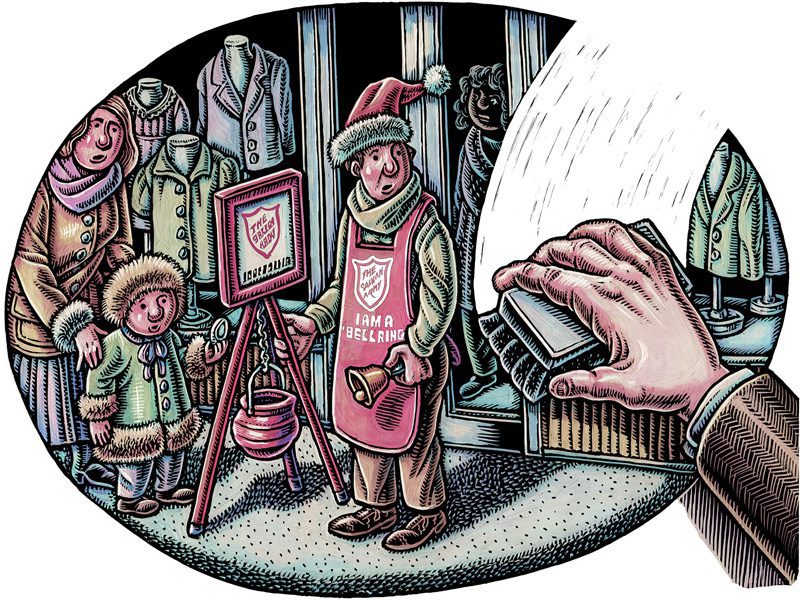The Red Kettle Campaign is The Salvation Army’s single biggest fundraiser, so how do you bounce back from a kettle theft—and deter it altogether?
By Jared McKiernan –
Tim stood outside the Lucky Supermarket at the Village Oaks Shopping Center in Martinez, California, donning a red apron, bell in hand, raising money for The Salvation Army. It was Nov. 23, 2019, the week before Thanksgiving, and the Red Kettle Campaign had just gotten underway.
Patrons dropped cash and coins in the kettle and Tim thanked each of them as they came and went from their shopping excursions. After a few hours, another volunteer approached Tim and told him his shift was done.
“I’ll take it from here.”
So Tim untied his apron and handed over the kettle, which had collected some $400, and the other volunteer loaded it up and drove off, presumably to count and process the donations. It was a routine handoff.
Or so Tim thought.
What he didn’t know: that “fellow volunteer” had just pulled off a scam. And just like that, the kettle and all of the donations inside were gone.
Three days later, at the Hobby Lobby in Concord, 10 minutes away, two men ambushed a bellringer outside the store, throwing water in her face as a diversion and making off with the kettle on bicycles.
“In my 30 years as a Salvation Army officer, I’d never had one stolen,” said Major Gwyn Jones, Concord Corps Officer. “Then we have two kettles taken in a span of three days.”
On Dec. 11, the bandits struck again in Concord, marking the third kettle theft in Contra Costa County for 2019.
While the East Bay was hit particularly hard, it wasn’t the only place where kettles were targeted. A slew of Salvation Army locations across the country made an appearance on the crime blotter for the same reason: Manitowoc, Wisconsin; Bradley, Illinois; Colorado Springs, Colorado; Tyler, Texas; Roseville, Michigan; Modesto, California; Plainfield, Indiana; St. Paul, Minnesota—the list goes on.
With kettles out in full force, so too are kettle crooks. Sometimes, it’s a simple, straightforward swiping. Other times, it’s a more sophisticated, calculated heist, such as in Martinez.
The money inside kettles, of course, is just the tip of the iceberg. A stolen kettle creates a serious issue, as perpetrators could pose as The Salvation Army and collect from unwitting passersby, eroding the trust of loyal supporters. It was a legitimate concern in Greater Winston-Salem, North Carolina, where thieves recently snatched six empty kettles, aprons and bells.
And though it’s hard to make sense of why someone would steal money collected on behalf of a charitable organization, it’s unfortunately a real possibility every year—putting a damper on an otherwise jolly season.
So what happens when a kettle gets stolen?
While each individual locality has some autonomy on how to handle theft, typically, the local corps will file a police report, notify the divisional business secretary, and alert the local media, whose coverage of the stolen kettle may well spark an outpouring of generosity from the public.
Case in point: Manitowoc. Just an hour after The Salvation Army posted a story about the theft on its Facebook page, the community stepped up in a big way. Jerry Duggan and Becky Tomchek, two local small business owners, immediately offered to donate the money needed to replace the kettle and stand. Others quickly followed suit, asking how they too could help.
As one of the donors put it, “there’s still good in the world.” And it’s true. A theft also poses a unique opportunity to raise awareness of what The Salvation Army’s collectively up against.
So how do you stop kettle theft, or at the very least, deter it?
“The safety of the bellringer always comes first,” said Major Harold Laubach, Modesto (California) Corps Officer. “So we do everything humanly possible to prevent this from happening. We need to take every precaution we can.”
For starters, securing the physical kettle to the stand with a sturdy padlock is an obvious measure. If a criminal can’t pry the kettle from the stand, they have no option but to try to make a break for it with the entire unit. Though it’s bulky and conspicuous, Laubach said it can still happen, albeit far less frequently.
According to Kathy Lovin, public affairs and communications manager for The Salvation Army USA Western Territory, the most important preventative measure is always proper bellringer training. One common sense approach, she said, is to ensure the kettle is never more than an arm’s length away from the bellringer.
Proper training also means establishing strong relationships with store employees, so that if a bellringer has to take a break, they bring the kettle stand inside the store (if they allow it) and have the store employee keep an eye on it so that it never goes “unattended.”
“That always helps,” Laubach said. “In the [Modesto theft], the store employees saw it happening and they ran outside to try and stop them. They got away, but I still think those relationships are very beneficial.”
Ultimately, you can never fully eliminate that risk. But keeping criminals honest should keep the focus of the Red Kettle Campaign where it belongs: on raising money to do the most good for those who need it most.
“We all know, biblically, you can’t stop evil all of the time,” Laubach said. “That’s just the way it is. Obviously, we pray for the success of our kettles, we pray for the safety of our bellringers, and we pray for our donors.”











